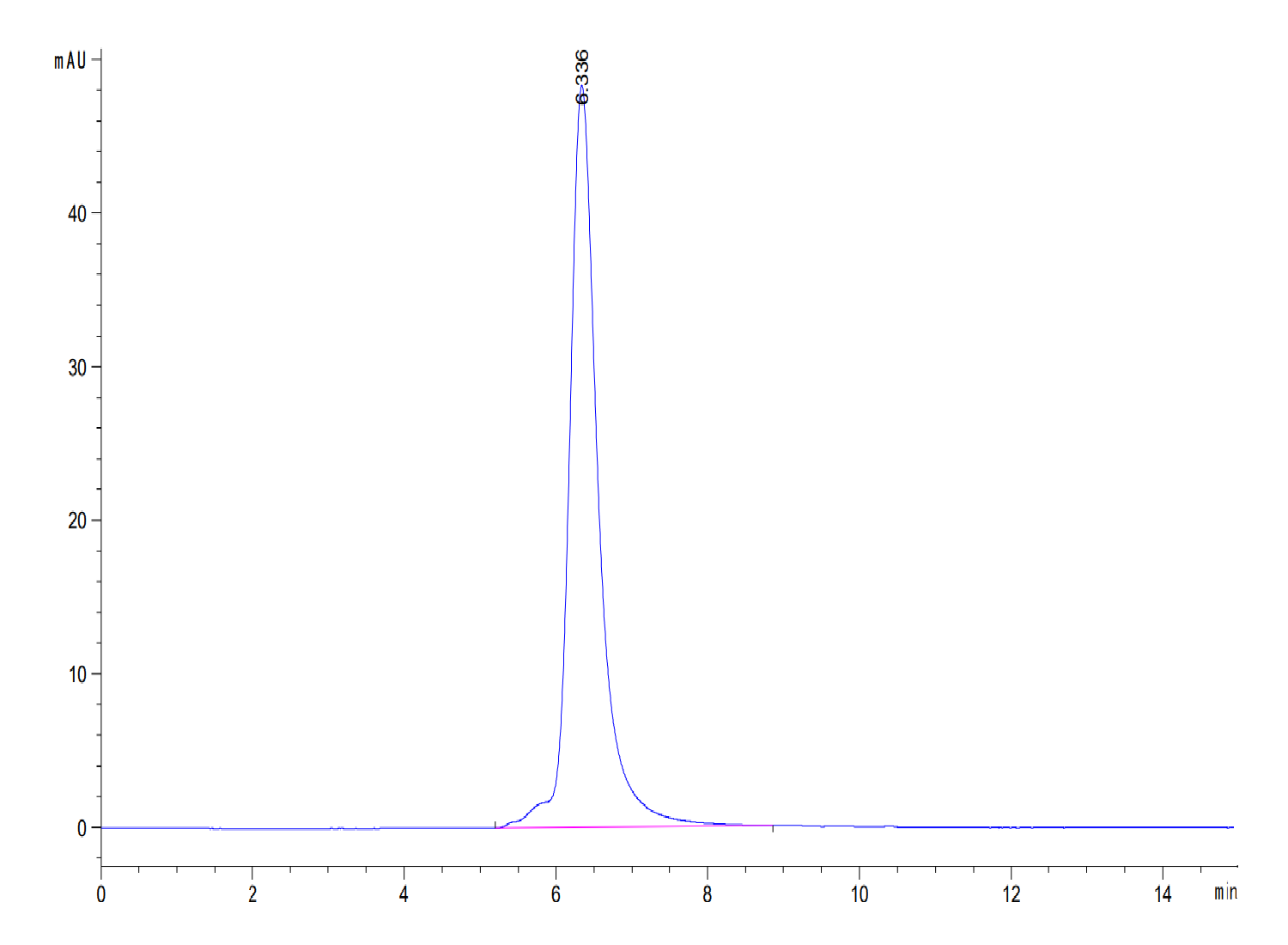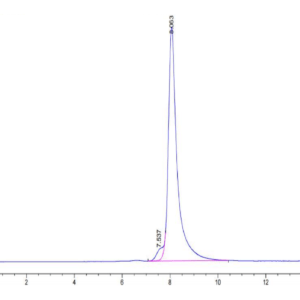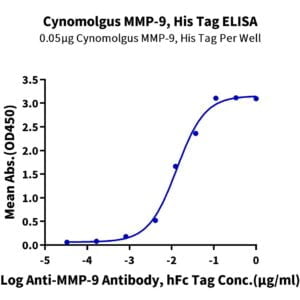| Weight | 1 lbs |
|---|---|
| Dimensions | 9 × 5 × 2 in |
| express system | HEK293 |
| product tag | C-His-Avi |
| purity | > 95% as determined by Tris-Bis PAGE;> 95% as determined by HPLC |
| background | Hepatitis A virus cellular receptor 2 (HAVCR2), also known as T-cell immunoglobulin and mucin-domain containing-3 (TIM-3), is a protein that in humans is encoded by the HAVCR2 gene.TIM3 is an immune checkpoint and together with other inhibitory receptors including programmed cell death protein 1 (PD-1) and lymphocyte activation gene 3 protein (LAG3) mediate the CD8 T-cell exhaustion. TIM3 has also been shown as a CD4 Th1-specific cell surface protein that regulates macrophage activation and enhances the severity of experimental autoimmune encephalomyelitis in mice. |
| molecular weight | The protein has a predicted MW of 22.8 kDa. Due to glycosylation, the protein migrates to 45-50 kDa based on Tris-Bis PAGE result. |
| available size | 100 µg, 500 µg |
| endotoxin | Less than 1EU per μg by the LAL method. |
Biotinylated Human Tim-3/HAVCR2 Protein 3343
$525.00 – $1,750.00
Summary
- Expression: HEK293
- Functional: Yes (ELISA)
- Amino Acid Range: Ser22-Arg200
Biotinylated Human Tim-3/HAVCR2 Protein 3343
| protein |
|---|
| Size and concentration 100, 500µg and lyophilized |
| Form Lyophilized |
| Storage Instructions Valid for 12 months from date of receipt when stored at -80°C. Recommend to aliquot the protein into smaller quantities for optimal storage. Please minimize freeze-thaw cycles. |
| Storage buffer Shipped at ambient temperature. |
| Purity > 95% as determined by Tris-Bis PAGE |
| target relevance |
|---|
| Hepatitis A virus cellular receptor 2 (HAVCR2), also known as T-cell immunoglobulin and mucin-domain containing-3 (TIM-3), is a protein that in humans is encoded by the HAVCR2 gene.TIM3 is an immune checkpoint and together with other inhibitory receptors including programmed cell death protein 1 (PD-1) and lymphocyte activation gene 3 protein (LAG3) mediate the CD8 T-cell exhaustion. TIM3 has also been shown as a CD4 Th1-specific cell surface protein that regulates macrophage activation and enhances the severity of experimental autoimmune encephalomyelitis in mice. |
| Protein names Hepatitis A virus cellular receptor 2 (HAVcr-2) (T-cell immunoglobulin and mucin domain-containing protein 3) (TIMD-3) (T-cell immunoglobulin mucin receptor 3) (TIM-3) (T-cell membrane protein 3) (CD antigen CD366) |
| Gene names HAVCR2,HAVCR2 TIM3 TIMD3 |
| Protein family Immunoglobulin superfamily, TIM family |
| Mass 9606Da |
| Function Cell surface receptor implicated in modulating innate and adaptive immune responses. Generally accepted to have an inhibiting function. Reports on stimulating functions suggest that the activity may be influenced by the cellular context and/or the respective ligand (PubMed:24825777). Regulates macrophage activation (PubMed:11823861). Inhibits T-helper type 1 lymphocyte (Th1)-mediated auto- and alloimmune responses and promotes immunological tolerance (PubMed:14556005). In CD8+ cells attenuates TCR-induced signaling, specifically by blocking NF-kappaB and NFAT promoter activities resulting in the loss of IL-2 secretion. The function may implicate its association with LCK proposed to impair phosphorylation of TCR subunits, and/or LGALS9-dependent recruitment of PTPRC to the immunological synapse (PubMed:24337741, PubMed:26492563). In contrast, shown to activate TCR-induced signaling in T-cells probably implicating ZAP70, LCP2, LCK and FYN (By similarity). Expressed on Treg cells can inhibit Th17 cell responses (PubMed:24838857). Receptor for LGALS9 (PubMed:16286920, PubMed:24337741). Binding to LGALS9 is believed to result in suppression of T-cell responses; the resulting apoptosis of antigen-specific cells may implicate HAVCR2 phosphorylation and disruption of its association with BAG6. Binding to LGALS9 is proposed to be involved in innate immune response to intracellular pathogens. Expressed on Th1 cells interacts with LGALS9 expressed on Mycobacterium tuberculosis-infected macrophages to stimulate antibactericidal activity including IL-1 beta secretion and to restrict intracellular bacterial growth (By similarity). However, the function as receptor for LGALS9 has been challenged (PubMed:23555261). Also reported to enhance CD8+ T-cell responses to an acute infection such as by Listeria monocytogenes (By similarity). Receptor for phosphatidylserine (PtSer); PtSer-binding is calcium-dependent. May recognize PtSer on apoptotic cells leading to their phagocytosis. Mediates the engulfment of apoptotic cells by dendritic cells. Expressed on T-cells, promotes conjugation but not engulfment of apoptotic cells. Expressed on dendritic cells (DCs) positively regulates innate immune response and in synergy with Toll-like receptors promotes secretion of TNF-alpha. In tumor-imfiltrating DCs suppresses nucleic acid-mediated innate immune repsonse by interaction with HMGB1 and interfering with nucleic acid-sensing and trafficking of nucleid acids to endosomes (By similarity). Expressed on natural killer (NK) cells acts as a coreceptor to enhance IFN-gamma production in response to LGALS9 (PubMed:22323453). In contrast, shown to suppress NK cell-mediated cytotoxicity (PubMed:22383801). Negatively regulates NK cell function in LPS-induced endotoxic shock (By similarity). |
| Catalytic activity #N/A |
| Subellular location Membrane ; Single-pass type I membrane protein. Cell junction. Cell membrane. Note=Localizes to the immunological synapse between CD8+ T-cells and target cells. |
| Tissues Expressed in T-helper type 1 (Th1) lymphocytes. Expressed on regulatory T (Treg) cells after TCR stimulation. Expressed in dendritic cells and natural killer (NK) cells. Expressed in epithelial tissues. Expression is increased on CD4+ and CD8+ T-cells in chronic hepatitis C virus (HCV) infection. In progressive HIV-1 infection, expression is up-regulated on HIV-1-specific CD8 T-cells. |
| Structure Interacts with HMGB1; impairs HMGB1 binding to B-DNA and likely HMGB1-mediated innate immune response (By similarity). Interacts with BAG6 (By similarity). Interacts (phosphorylated) with PIK3R1 and PIK3R2. Interacts (not dependent on its phosphorylation status) with FYN (By similarity). Interacts (in basal state T-cells) with VAV1; AKT1/2, LCP2, ZAP70, SYK, PIK3R1, FYN, SH3BP2 and SH2D2A. Interacts (in activated T-cells) with LCK and PLCG (PubMed:24337741, PubMed:26492563). Interacts with ILF3; this interaction promotes ILF3 ubiquitination and degradation (PubMed:34110282). |
| Post-translational modification O-glycosylated with core 1 or possibly core 8 glycans.; Phosphorylated on tyrosine residues; modestly increased after TCR/CD28 stimulation. Can be phosphorylated in the cytoplasmatic domain by FYN (By similarity). Phosphorylation at Tyr-265 is increased by stimulation with ligand LGALS9. |
| Target Relevance information above includes information from UniProt accession: Q8TDQ0 |
| The UniProt Consortium |
Data
Publications
Publications
| pmid | title | authors | citation |
|---|---|---|---|
| We haven't added any publications to our database yet. | |||
Protocols
| relevant to this product |
|---|
Documents
| # | ||
|---|---|---|
| Please enter your product and batch number here to retrieve product datasheet, SDS, and QC information. | ||

















